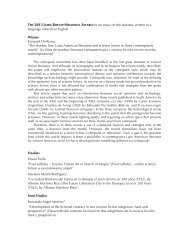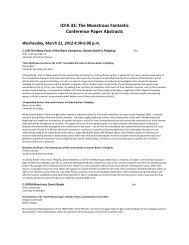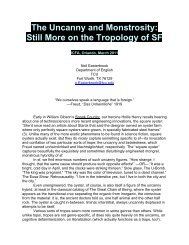The Monstrous Fantastic Conference Paper Abstracts - International ...
The Monstrous Fantastic Conference Paper Abstracts - International ...
The Monstrous Fantastic Conference Paper Abstracts - International ...
Create successful ePaper yourself
Turn your PDF publications into a flip-book with our unique Google optimized e-Paper software.
21. (CYA) Terrifying Futures: Post-Apocalyptic, Post-Human Dystopias MapleChair: Chris TokuhamaUniversity of South CaliforniaOur Cyborgs, Ourselves: Nature, Networks, and the Body in Recent Young Adult Science FictionAlaine MartausUniversity of Illinois, Urbana-ChampaignIn her seminal text, A Cyborg Manifesto, Donna Harraway argues that the cyborg is “a creature of social reality as well as a creature of fiction.”While Harraway’s interest is in setting up the cyborg as an object through which to understand gender as a subject of scientific inquiry, thispaper extends the metaphor to set up the adolescent as a cyborg figure: a socially-created creature neither innocent child nor responsibleadult, largely understood in contemporary observations as unnaturally attached to networked machines. Drawing on concepts from prominentscience studies scholars, including Bruno Latour and Donna Haraway, alongside those of science fiction writers and scholars, including RobertScholes and Bruce Sterling, this paper explores the ways in which contemporary science fiction for young adults sets up an seeminglyimpermeable barrier between networked spaced and the natural world while at the same time using the body as a place where nature and themachine overlap as a way of exploring contemporary concerns about adolescents and their engagement with the larger world. It investigatesthe ways in which the protagonists of these novels function within these dichotomous spaces, how they understand the barriers between thenatural and the technological, and how they come to question the “black boxes” and social norms that their society has built up around thetechnological. In order to establish a pattern of interest across the genre, this paper draws examples from a variety of novels from the pastdecade, beginning with M.T. Anderson’s Feed (2002) and including key texts like Scott Westerfeld’s Uglies (2005), Cory Doctorow’s LittleBrother (2008), Ally Condie’s Matched (2010), and Lauren Oliver’s Delirium (2011).<strong>Fantastic</strong> Posthumanism: Horcuxes, Pensieves, and Transplanting ConsciousnessKristina Jean LareauSimmons CollegeThis paper explores the evolution of magic in the world of Harry Potter as it parallels the evolution of the technology of the modern world.From the body as organic to the additions of either magic or technology, both wizard and Muggle evolve from human to posthuman by seekingto prolong life or extend the body into foreign objects, be it Horcruxes or a prosthetic leg. It explores questions of how literature privilegeshumanism to posthumanism, despite the existence of the posthuman in both life and literature. This paper seeks to understand the humanpropensity and desire for immortality through both technology and literature using examples from the fantastic realm (Voldemort andDumbledore from the Harry Potter Series), from the science fiction realm (Jenna from Adoration of Jenna Fox and Lia from the Skinned trilogy),and Stelarc’s mechanical third hand from the reality of technology. For example, Dumbledore does not split his soul to prolong his life; herecognizes Professor Slughorn’s emphasis that, “the soul is supposed to remain intact and whole. Splitting it is an act of violation, it is againstnature” (Rowling, Half-Blood, 498). For over a hundred years, Dumbledore was interested in the immortality offered through the unification ofthree magical items—the Deathly Hallows—purported to make their owner “master of death” or immortal. Most of the wizarding worldbelieves the magic of the Hallows to be a legend; yet similarities exist in our world: mixed with urban legend is Walt Disney’s frozen body,waiting for immortality with the retainer of a wealthy estate to be reanimated with the development of that technology. Disney is in essence,waiting to become posthuman. <strong>The</strong> corruption of humanism that has evolved into the “monstrosities” of posthumanism suggests that literaturecan unite science, science fiction and literature.Candy, Dog Food, and Tears: Food-Sharing in Young Adult Post-Apocalyptic FictionLeisa ClarkUniversity of South FloridaGiven the choice between broccoli and candy, most people would choose the chocolate confection, and when children are the only survivors ofan apocalyptic event, inevitably sugared treats and confections are preferred over canned beets, rice and beans when grocery stores are pickedclean by young people left to fend for themselves. As food becomes scarcer, previously eschewed victuals become priceless, to the point wherefried dog food may be a delicacy. Food is often valued by availability, so in a culture of abundance, empty calories can be chosen over healthyoptions because the healthy options are still available. In nearly all cases of novels in which disasters destroy populations over the age ofmajority, food preparation and access become critical. For this reason, many plots in post-apocalyptic novels center on food procurement. Thisrequires the protagonist(s) to first find a secure home, and then to locate a safe and abundant food source. In almost every example, this isattained only by joining up with others who are in a similar position and creating a community for the purpose of survival. <strong>The</strong> codifiedmessages about responsibility for food production can be found throughout apocalyptic/post-apocalyptic novels, where women and girls areoften relegated to hearth and home, and men and boys to “outside” and defense of the home. This message of responsibility is demonstratedclearly in young adult novels, where more often than not, girls become the homemakers, laying down the rules about food preparation andconsumption, even when boys are the bread-winners. This paper argues that, when they are left without adult supervision or guidance,children in young adult post-apocalyptic novels successfully respond to the need for food by creating small communities that often mimic thesocieties that have fallen, while those who fail to share food are often marginalized or ostracized from the rest.





